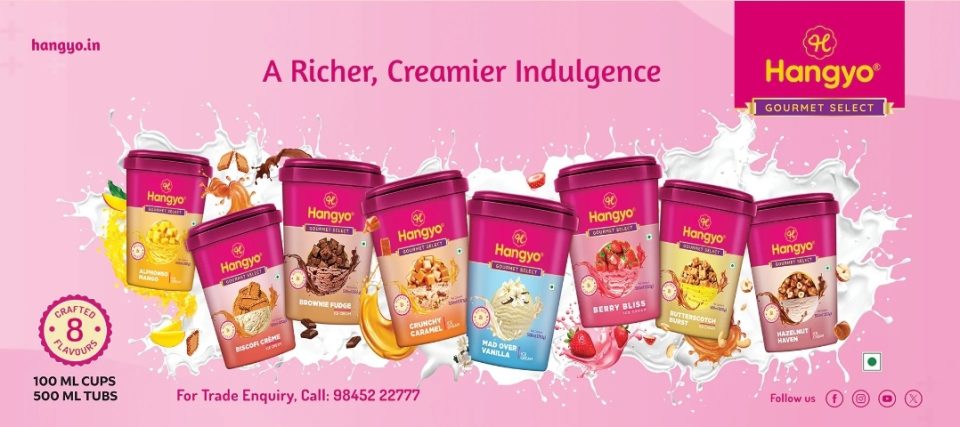Picture this: You’re walking through the bustling streets of Mangalore on a sweltering afternoon. Suddenly, you spot that familiar Hangyo ice cream cart. Your taste buds immediately perk up, remembering the creamy goodness you’ve enjoyed countless times before. This scenario plays out thousands of times daily across Southern India, demonstrating Hangyo’s remarkable customer experience strategy.
The Sweet Journey from Customer Need to Market Leadership
Today, Hangyo Ice Creams announces a significant milestone in their expansion journey. The company ramps up production capacity to meet soaring demand across Karnataka, Kerala, and Goa. Currently, they produce 1.25 lakh litres daily while maintaining an impressive annual turnover of ₹300 crores.
But what truly sets Hangyo apart isn’t just their production numbers. Instead, it’s their unwavering focus on understanding and exceeding customer expectations. Since 1997, the Pai brothers have built more than just an ice cream brand. They’ve created a customer experience ecosystem that resonates deeply with Southern Indian consumers.
Understanding the Customer Experience Foundation
Initially, Hangyo’s success stemmed from identifying a crucial customer pain point. Before their entry, premium ice cream options remained limited in tier-2 and tier-3 cities. Consequently, customers often settled for inferior products or traveled long distances for quality treats.
Moreover, the founders recognized that customer experience extends beyond product quality. They understood that accessibility, affordability, and cultural relevance matter equally. Therefore, they designed their entire business model around these customer-centric principles.
Furthermore, their approach to franchising demonstrates deep customer insight. Rather than imposing standardized solutions, they adapted their Hangyo Softees model to local preferences. This flexibility allowed them to expand rapidly while maintaining customer satisfaction across diverse markets.
The Strategic Customer Experience Framework
Distribution Excellence as Customer Experience
Hangyo’s distribution network exemplifies customer-first thinking. With over 40,000 retail outlets and 450+ distributors, they ensure product availability wherever customers need it. Additionally, this extensive network reduces waiting times and eliminates the frustration of product unavailability.
Subsequently, their regional approach creates deeper customer connections. By establishing production facilities in Jamkhandi, Heroor, and Kirwatti, they reduce delivery times significantly. This strategy also ensures fresher products reach customers faster, enhancing overall satisfaction.
Innovation Driven by Customer Feedback
Remarkably, Hangyo’s product development process centers on customer insights. When they introduced softee ice creams to Mangalore in 1997, they responded to overwhelming customer demand. The positive response validated their customer-centric approach and fueled rapid expansion.
Similarly, their transition into hard ice creams addressed evolving customer preferences. As consumer tastes diversified, Hangyo adapted accordingly. They invested in cutting-edge machinery and expanded their SKU range to include cups, candy, and novelties.
Quality as a Customer Experience Differentiator
Notably, Hangyo’s commitment to quality reflects their understanding of customer expectations. Their greenfield plant in Kirwatti features advanced technology sourced from China. This investment ensures consistent product quality while meeting growing demand efficiently.
Additionally, their “farmer-first philosophy” creates an authentic customer story. Customers increasingly value brands that support local communities and sustainable practices. Therefore, Hangyo’s direct farmer procurement model resonates strongly with socially conscious consumers.
Analyzing the Customer Experience Impact
Quantitative Customer Experience Metrics
From a data perspective, Hangyo’s growth trajectory reveals impressive customer experience metrics. Their expansion from a single softee outlet to over 50 outlets demonstrates strong customer adoption. Moreover, their current production capacity of 1.25 lakh litres daily indicates sustained customer demand.
Furthermore, their ₹300 crore annual turnover suggests high customer lifetime value. This revenue figure reflects not just initial purchases but repeat business and customer loyalty. Consequently, their customer retention rates likely exceed industry averages significantly.
Geographic Market Penetration Analysis
Strategically, Hangyo’s geographic expansion follows customer demand patterns. Their presence across Karnataka, Kerala, Goa, Andhra Pradesh, Telangana, Tamil Nadu, and Maharashtra demonstrates systematic market development. Each new territory represents validated customer interest and sustainable demand.
Additionally, their focus on tier-2 and tier-3 cities addresses underserved customer segments. This approach creates competitive advantages while building strong local customer relationships. Therefore, their market penetration strategy directly correlates with customer satisfaction levels.
Customer Journey Optimization
Analytically, Hangyo’s customer journey spans multiple touchpoints effectively. From initial product discovery through purchase and consumption, they maintain consistent quality standards. Their franchise model ensures standardized customer experiences across different locations.
Moreover, their participation in international forums like ANUGA and World Ice Cream Expo demonstrates commitment to global best practices. This knowledge transfer ultimately benefits customers through improved products and services.
The Competitive Customer Experience Advantage
Market Positioning Through Customer Value
Competitively, Hangyo’s customer experience strategy creates sustainable differentiation. While competitors focus primarily on product features, Hangyo emphasizes holistic customer satisfaction. This approach builds emotional connections that transcend traditional price-based competition.
Furthermore, their regional focus allows deeper customer understanding compared to national brands. Local preferences, cultural nuances, and seasonal variations receive more attention. Consequently, their products align better with specific customer needs and expectations.
Innovation as Customer Experience Enhancement
Technologically, Hangyo’s investment in advanced manufacturing equipment enhances customer experience indirectly. Better machinery produces more consistent products while reducing production costs. These benefits ultimately reach customers through improved quality and competitive pricing.
Additionally, their R&D investments focus on customer preference analysis. Understanding flavor preferences, texture expectations, and packaging requirements drives product development decisions. This customer-centric innovation approach ensures market relevance and sustained growth.
Future Customer Experience Implications
Scaling Customer Experience Excellence
Looking ahead, Hangyo’s expansion plans must maintain customer experience quality. As production capacity increases, they must ensure consistent product quality across all outlets. This challenge requires systematic quality management and continuous training programs.
Similarly, their growing distribution network needs standardized customer service protocols. Maintaining brand consistency while accommodating local preferences requires sophisticated operational management. Therefore, their customer experience systems must scale proportionally with business growth.

Digital Transformation and Customer Experience
Strategically, Hangyo’s future success depends on digital customer experience integration. Modern consumers expect seamless online-offline experiences, real-time order tracking, and personalized recommendations. Consequently, their traditional retail model must evolve to meet these expectations.
Furthermore, data analytics will become increasingly important for customer experience optimization. Understanding customer behavior patterns, preference trends, and satisfaction drivers requires sophisticated analytical capabilities. Therefore, technology investments must complement their operational excellence initiatives.
Conclusion: The Customer Experience-Driven Success Formula
Ultimately, Hangyo’s remarkable journey from a modest dairy initiative to a ₹300 crore ice cream brand exemplifies customer experience excellence. Their success stems from consistently prioritizing customer needs over short-term profit maximization. This approach creates sustainable competitive advantages while building lasting customer relationships.
As they continue expanding across Southern India, their customer-centric philosophy remains their greatest asset. By maintaining this focus while embracing technological advancement, Hangyo positions itself for continued success in India’s dynamic ice cream market. Their story demonstrates that exceptional customer experience isn’t just good business practice—it’s the foundation of sustainable growth and market leadership.

